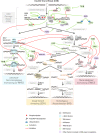Role of EMT in the DNA damage response, double-strand break repair pathway choice and its implications in cancer treatment
- PMID: 35534984
- PMCID: PMC9277259
- DOI: 10.1111/cas.15389
Role of EMT in the DNA damage response, double-strand break repair pathway choice and its implications in cancer treatment
Abstract
Numerous epithelial-mesenchymal transition (EMT) characteristics have now been demonstrated to participate in tumor development. Indeed, EMT is involved in invasion, acquisition of stem cell properties, and therapy-associated resistance of cancer cells. Together, these mechanisms offer advantages in adapting to changes in the tumor microenvironment. However, recent findings have shown that EMT-associated transcription factors (EMT-TFs) may also be involved in DNA repair. A better understanding of the coordination between the DNA repair pathways and the role played by some EMT-TFs in the DNA damage response (DDR) should pave the way for new treatments targeting tumor-specific molecular vulnerabilities, which result in selective destruction of cancer cells. Here we review recent advances, providing novel insights into the role of EMT in the DDR and repair pathways, with a particular focus on the influence of EMT on cellular sensitivity to damage, as well as the implications of these relationships for improving the efficacy of cancer treatments.
Keywords: DNA damage response; DNA repair; ZEB1; epithelial-mesenchymal transition; synthetic lethality.
© 2022 The Authors. Cancer Science published by John Wiley & Sons Australia, Ltd on behalf of Japanese Cancer Association.
Conflict of interest statement
HS received a research grant from the Nippon Foundation and is Associate Editor and Secretary for Editor‐in‐Chief of
Figures


Similar articles
-
Deeper Insight in Metastatic Cancer Progression; Epithelial-to- Mesenchymal Transition and Genomic Instability: Implications on Treatment Resistance.Curr Mol Med. 2021;21(10):860-871. doi: 10.2174/1566524021666210202114844. Curr Mol Med. 2021. PMID: 33530906
-
MiR-652 inhibits acidic microenvironment-induced epithelial-mesenchymal transition of pancreatic cancer cells by targeting ZEB1.Oncotarget. 2015 Nov 24;6(37):39661-75. doi: 10.18632/oncotarget.5350. Oncotarget. 2015. PMID: 26498682 Free PMC article.
-
Cancer-associated transcription factors in DNA damage response.Biochim Biophys Acta Rev Cancer. 2022 Jul;1877(4):188757. doi: 10.1016/j.bbcan.2022.188757. Epub 2022 Jun 30. Biochim Biophys Acta Rev Cancer. 2022. PMID: 35781034 Review.
-
Epigenetic Regulation of Inflammatory Cytokine-Induced Epithelial-To-Mesenchymal Cell Transition and Cancer Stem Cell Generation.Cells. 2019 Sep 25;8(10):1143. doi: 10.3390/cells8101143. Cells. 2019. PMID: 31557902 Free PMC article. Review.
-
The genomics of desmoplastic small round cell tumor reveals the deregulation of genes related to DNA damage response, epithelial-mesenchymal transition, and immune response.Cancer Commun (Lond). 2018 Nov 28;38(1):70. doi: 10.1186/s40880-018-0339-3. Cancer Commun (Lond). 2018. PMID: 30486883 Free PMC article.
Cited by
-
FNDC5 affects invasion and migration of oral cancer by inhibiting PI3K/Akt/Snail signaling pathway.Sci Rep. 2024 Nov 6;14(1):26881. doi: 10.1038/s41598-024-78391-6. Sci Rep. 2024. PMID: 39505986 Free PMC article.
-
Advances in research regarding epithelial-mesenchymal transition and prostate cancer.Front Cell Dev Biol. 2025 May 30;13:1583255. doi: 10.3389/fcell.2025.1583255. eCollection 2025. Front Cell Dev Biol. 2025. PMID: 40519259 Free PMC article. Review.
-
Chromatin licensing and DNA replication factor 1 as a potential prognostic and diagnostic biomarker for gastric cancer.Sci Rep. 2024 Dec 28;14(1):31000. doi: 10.1038/s41598-024-81977-9. Sci Rep. 2024. PMID: 39730687 Free PMC article.
-
Suppression of Metastatic Ovarian Cancer Cells by Bepridil, a Calcium Channel Blocker.Life (Basel). 2023 Jul 22;13(7):1607. doi: 10.3390/life13071607. Life (Basel). 2023. PMID: 37511982 Free PMC article.
-
Large-scale analysis of CDH1 mutations defines a distinctive molecular subset with treatment implications in gastric cancer.NPJ Precis Oncol. 2024 Sep 30;8(1):214. doi: 10.1038/s41698-024-00694-8. NPJ Precis Oncol. 2024. PMID: 39349771 Free PMC article.
References
-
- Ahmed SU, Carruthers R, Gilmour L, Yildirim S, Watts C, Chalmers AJ. Selective inhibition of parallel DNA damage response pathways optimizes radiosensitization of glioblastoma stem‐like cells. Cancer Res. 2015;75(20):4416‐4428. - PubMed
-
- Stiff T, O’Driscoll M, Rief N, Iwabuchi K, Löbrich M, Jeggo PA. ATM and DNA‐PK function redundantly to phosphorylate H2AX after exposure to ionizing radiation. Cancer Res. 2004;64(7):2390‐2396. - PubMed
Publication types
MeSH terms
Substances
Grants and funding
LinkOut - more resources
Full Text Sources
Medical

